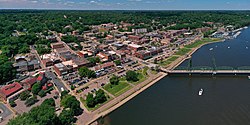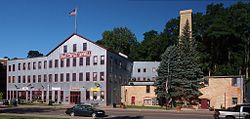Stillwater, Minnesota
Stillwater is a city in Washington County, Minnesota. It is on the St. Croix River directly across from the state of Wisconsin. The population was 19,394 at the 2020 census.[3] It is the county seat.[4] Stillwater is part of the Twin Cities Metro Area.
 | |
|
| |
 Location of the city of Stillwater within Washington County, Minnesota | |
| Coordinates: 45°3′N 92°49′W / 45.050°N 92.817°WCoordinates: 45°3′N 92°49′W / 45.050°N 92.817°W | |
| Country | United States |
| State | Minnesota |
| County | Washington |
| First settled | October 26, 1843 |
| Area | |
| • Total | 9.07 sq mi (23.50 km2) |
| • Land | 8.05 sq mi (20.84 km2) |
| • Water | 1.03 sq mi (2.66 km2) |
| Elevation | 866 ft (264 m) |
| Population | |
| • Total | 19,394 |
| • Density | 2,410.39/sq mi (930.66/km2) |
| Time zone | UTC−6 (CST) |
| • Summer (DST) | UTC−5 (CDT) |
| ZIP Codes | 55082, 55083 |
| FIPS code | 27-62824 |
| GNIS feature ID | 2395969[2] |
| Website | www.ci.stillwater.mn.us |
History
Treaties
On July 29 and September 29, 1837, treaties were signed between the US government and the local Ojibwa and Dakota nations. They allowed settlement in the St. Croix River Valley. The town was founded by settlers drawn by the area's then-abundant lumber and river traffic. It is one of Minnesota's oldest towns, preceding Minneapolis by several years. Stillwater was officially incorporated as a city on March 4, 1854 (the same day as St. Paul). The city was named for the calm waters of the St. Croix River.[5]
Territorial convention
Stillwater is often called the birthplace of Minnesota.[6] In 1848, a territorial convention that began the process of establishing Minnesota as a state was held in Stillwater. The convention selected three leading Minnesota cities as locations for three important public institutions. Minneapolis got the University of Minnesota, Saint Paul became the capital, and Stillwater was chosen as the site of the territory's first prison. The Minnesota Territorial Prison was opened in 1853.
Lumbering era
Lumbering was the main industry in the St. Croix River Valley in the second half of the nineteenth century. For many years logs were sent down the St. Croix river, collected at the St. Croix Boom Site two miles upstream of Stillwater, and processed in Stillwater's many sawmills. Steamboats were used most widely from 1860 to 1890, and a few are still used for entertainment today.
Civil war
Stillwater sent men of the 1st Minnesota Volunteer Infantry Company B and the 8th Minnesota Volunteer Infantry Regiment Company C to fight during the American Civil War.[7][8]
Stillwater, Minnesota Media
References
- ↑ "2020 U.S. Gazetteer Files". United States Census Bureau. Retrieved July 24, 2022.
- ↑ 2.0 2.1 U.S. Geological Survey Geographic Names Information System: Stillwater, Minnesota
- ↑ 3.0 3.1 "QuickFacts: Stillwater city, Minnesota". United States Census Bureau. Retrieved February 21, 2024.
- ↑ "Find a County". National Association of Counties. Retrieved 2011-06-07.
- ↑ Chicago and North Western Railway Company (1908). A History of the Origin of the Place Names Connected with the Chicago & North Western and Chicago, St. Paul, Minneapolis & Omaha Railways. p. 165.
- ↑ William E. Lass. "The Birth of Minnesota" (PDF). Minnesota Historical Society. Archived from the original (PDF) on 22 February 2012. Retrieved 12 September 2015.
- ↑ "From the Journal of Sgt. Sam Bloomer, 1st Minnesota Volunteer Infantry Part I". This Week in the Civil War. Retrieved 12 September 2015.
- ↑ "Historians seek Stillwater Civil War unit's flag". This Week in the Civil War. Retrieved 12 September 2015.
| Wikimedia Commons has media related to Lua error in Module:Commons_link at line 62: attempt to index field 'wikibase' (a nil value).. |






